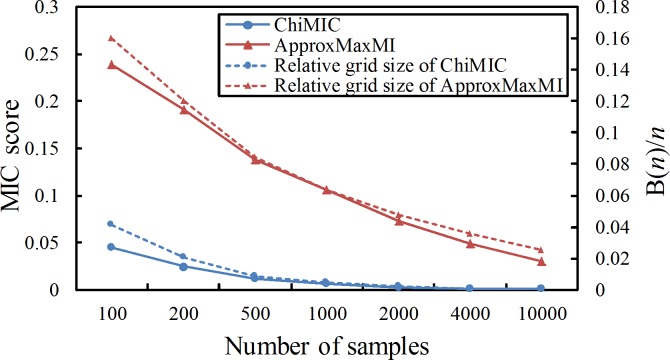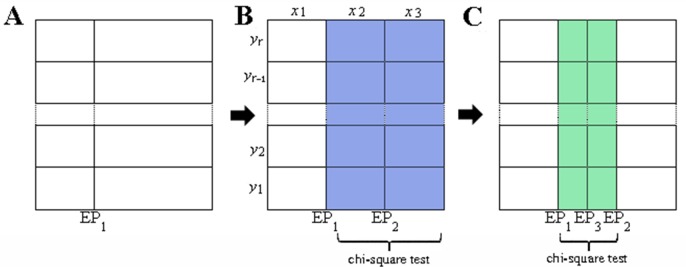Abstract
The maximal information coefficient (MIC) captures dependences between paired variables, including both functional and non-functional relationships. In this paper, we develop a new method, ChiMIC, to calculate the MIC values. The ChiMIC algorithm uses the chi-square test to terminate grid optimization and then removes the restriction of maximal grid size limitation of original ApproxMaxMI algorithm. Computational experiments show that ChiMIC algorithm can maintain same MIC values for noiseless functional relationships, but gives much smaller MIC values for independent variables. For noise functional relationship, the ChiMIC algorithm can reach the optimal partition much faster. Furthermore, the MCN values based on MIC calculated by ChiMIC can capture the complexity of functional relationships in a better way, and the statistical powers of MIC calculated by ChiMIC are higher than those calculated by ApproxMaxMI. Moreover, the computational costs of ChiMIC are much less than those of ApproxMaxMI. We apply the MIC values tofeature selection and obtain better classification accuracy using features selected by the MIC values from ChiMIC.
Introduction
Identifying relationships between variables is an important scientific task in exploratory data mining [1]. Many measures have been developed, such as Pearson correlation coefficient [2], Spearman rank correlation coefficient, Kendall coefficient of concordance [3], mutual information estimators [4],[5],[6], distance correlation (dCor) [7], and correlation along a generating curve [8]. Recently, Reshef et al. [9] proposed a novel maximal information coefficient (MIC) measure to capture dependences between paired variables, including both functional and non-functional relationships [10],[11]. The MIC value has been applied successfully to many problems [12–20]. The MIC of a pair of data series x and y is defined as follow:
| (1) |
where I(x, y) is the mutual information between data x and y. The nx, ny are the number of bins into which x and y are partitioned, respectively. Reshef et al. [9] developed a dynamic program algorithm, ApproxMaxMI, to calculate the MIC. As the bin sizes affect the value of mutual information, determining the appropriate value of nx and ny is important. In ApproxMaxMI algorithm, Reshef set the nx×ny˂ B(n), where B(n) = n0.6 is the maximal grid size restriction and n is the sample size. The generality of MIC is closely related to B(n). Setting B(n) too low will result in searching only for simple patterns and weakening the generality, while setting B(n) too high, will result in nontrivial MIC score for independent paired variables under finite samples. For example, the MIC value of two independent variables with 400 sample points calculated by ApproxMaxMI is 0.15±0.017 (B(n) = n0.6, 500 replicates). Furthermore, the computation cost of ApproxMaxMI becomes expensive when the sample size n is large, which makes it difficult to calculate the MIC for big data.
Many efforts have been committed to improve the approximation algorithm for MIC by either optimizing the MIC value or reducing the computing time. Tang et al. [21] have proposed a cross-platform tool for the rapid computation of the MIC based on parallel computing methods. Wang et al. [22] have used quadratic optimization to calculate the MIC. Albanese et al. [23] re-implemented the ApproxMaxMI using C.[9]. Zhang et al. [10] have applied the simulated annealing and genetic algorithm, SGMIC, to optimize the MIC. Although SGMIC can achieve better MIC values, it is much more time-consuming.
In this paper, we develop a new algorithm to improve the MIC values as well as reduce the computational cost. Our new algorithm, ChiMIC, uses the chi-square test to determinate optimal bin size for the calculating of MIC value. Experiments on simulated data with different relationships (e.g. statistically independent, noiseless functional and noisy functional relationships) and real data show that our method can optimize the MIC value and significantly reduce the computation time.
Results
Comparison of MIC values for independent and noiseless functional relationships
Ideally, the MIC values should be close to 0 for two independent variables. The MIC values for two independent variables calculated by ApproxMaxMI depend on the ratio between B(n) and n [24]. The MIC value for two independent variables is close to 0 only when n approaches infinity, namely, the B(n)/n trends to 0. Although, the MIC values calculated by ChiMIC also depend on B(n)/n, the ChiMIC algorithm gives much smaller MIC values for independent variables and converges to zero faster as shown in Fig 1. Specifically, for small sample sizes, the MIC values calculated by ChiMIC are much smaller. For example, when sample size is 100, MIC value calculated by ChiMIC is 0.06, while MIC value calculated by ApproxMaxMI is 0.24.
Fig 1. MIC values calculated by ApproxMaxMI and ChiMIC for random data with different sample sizes.
The scores are reported as means over 500 replicates.
Meanwhile, the MIC values of two variables with noiseless functional relationships should be close to 1. We calculate the MIC values between variables with 21 different noiseless functional relationships (S1 Fig) using ChiMIC algorithm. All MIC values are equal to 1 as shown in S1 Table, which indicates that the ChiMIC algorithm maintains the generality of MIC.
Comparison of grid partition for noisy relationships
For noise relationships, the ChiMIC algorithm terminates the grid partition search much earlier than ApproxMaxMI. As shown in Fig 2, both ChiMIC and ApproxMaxMI capture a noiseless linear relationship with a 2×2 grid (Fig 2A). When adding noise, the ApproxMaxMI partitions the noisy linear relationship with a 2×32 grid (Fig 2B). Meanwhile, ChiMIC partitions the noisy linear relationship with just a 2×4 grid (Fig 2C). We also compare the grid partition for parabolic function (Fig 3) and sinusoidal function (Fig 4). As shown in Figs 3 and 4, the ChiMIC algorithm partitions the noisy functional relationship into much fewer numbers of grids. The fewer numbers the grid are partitioned, the smaller the MIC values are calculated. The MIC values calculated by ChiMIC algorithm are always smaller than those calculated by ApproxMaxMI. We calculate the MIC values for 21 functional relationships with different noise levels (S2 Table). The higher the noise level, the smaller the MIC values calculated by ChiMIC comparing to those calculated by ApproxMaxMI.
Fig 2. Grid partition of ApproxMaxMI and ChiMIC for linear function.
1000 data points simulated for functional relationships of the form y = x+η. where η is noise drawn uniformly from (−0.25, 0.25). A: Grid partition for noiseless linear function. B: Grid partition based on ApproxMaxMI for noisy linear function. C: Grid partition based on ChiMIC for noisy linear function.
Fig 3. Grid partition of ApproxMaxMI and ChiMIC for parabolic function.
1000 data points simulated for functional relationships of the form y = 4x2+η. where η is noise drawn uniformly from (−0.25, 0.25). A: Grid partition for noiseless parabolic function. B: Grid partition based on ApproxMaxMI for noisy parabolic function. C: Grid partition based on ChiMIC for noisy parabolic function.
Fig 4. Grid partition of ApproxMaxMI and ChiMIC for sinusoidal function.
1000 data points simulated for functional relationships of the form y = sin(4πx)+η. where η is noise drawn uniformly from (−0.25, 0.25). A: Grid partition for noiseless sinusoidal function. B: Grid partition based on ApproxMaxMI for noisy sinusoidal function. C: Grid partition based on ChiMIC for noisy sinusoidal function.
Comparison of minimum cell number (MCN) estimation
In maximal information-based nonparametric exploration statistics, the minimum cell number (MCN) is the number of grid cells needed to calculate MIC values. It is defined as follows [24]:
| (2) |
where D is a finite set of ordered paired data. The parameterε provides robustness for MCN. This measure captures the complexity of the association between two variables. A greater MCN measure indicates a more complex association.
For independent variables, MCN is equal to 2 and is unrelated to sample size. When ε is set to 0, the MCN measure based on MIC calculated by ApproxMaxMI increases steadily as the sample size grows (Fig 5). When ε is set to 1-MIC(D) as in Reshef [24], the MCN measures based on MIC calculated by ApproxMaxMI algorithm do not increase as sample size grows, but still maintain greater than 3. On the other hand, the MCN values based on MIC calculated by ChiMIC are always close to 2.
Fig 5. MCN values of independent variables for different sample sizes.
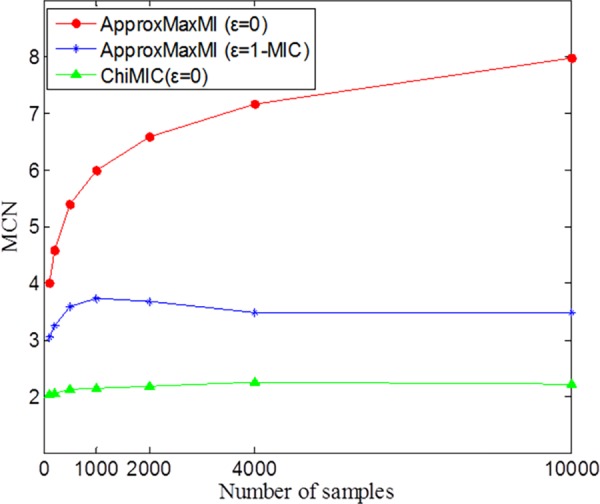
The values are reported as means over 500 replicates.
For noiseless linear, parabolic and sinusoidal functions, the MCN values are 2, 2.58 and 3, respectively, for MIC calculated by either ApproxMaxMI or ChiMIC (Fig 6). As MCN values increase as the complexity of functional relationships increases, the MCN values should increase when weak noise is added. However, when the level of noise blurs the real functional relationship, the MCN values should decrease and converge towards 2. Thus, the MCN values should follow a parabolic graph as the noise level increases. We examine the MCN values when different levels of noise are added to linear, parabolic and sinusoidal functions. When ε is set to 0 and noise level is greater than or equal to 0.4, the MCN values based on MIC calculated by ApproxMaxMI are always equal to 6 for all three functions (Fig 6A). Thus, MCN can no longer capture the complexity of functional relationships in this case. When ε is set to 1-MIC(D), only the MCN values based on MIC calculated by ApproxMaxMI for linear function follow the parabolic form. The MCN values based on MIC calculated by ApproxMaxMI for parabolic and sinusoidal functions do not follow the parabolic form, and cannot reflect the complexity of functional relationships under some noise levels (Fig 6B). When ε is set to 0, MCN values based on MIC calculated by ChiMIC for all three functions follow the parabolic form (Fig 6C). However, the MCN values do not converge to 2. When ε is set to 1-MIC(D), MCN values based on MIC calculated by ChiMIC for all three functions not only follow the parabolic form, but also converge to 2 when noise reaches in certain level. These results imply that MCN values based on MIC calculated by ChiMIC can capture the complexity of functional relationships in a better way.
Fig 6. MCN values for linear, parabolic and sinusoidal functions at different noise levels.
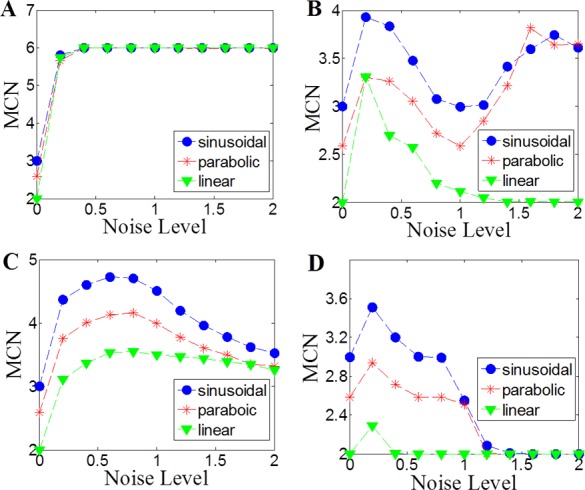
A MCN estimates with MIC (ε = 0), B MCN estimates with MIC (ε = 1-MIC), C MCN estimates for ChiMIC (ε = 0), D MCN estimates for ChiMIC (ε = 1-MIC). MCN estimates were computed for n = 1000 data points over 500 replicates. Each relationship listed, is the same as in Figs 2–4. Where y = f(x)+η, η was uniform noise of amplitude equal to the range of f(x) times one of these 12 relative amplitudes:0, 0.2, 0.4, 0.6, 0.8, 1.0, 1.2,1.4, 1.6, 1.8, 2.0.
Comparison of statistical power
The power of a statistical test is an important concept in hypotheses testing [25]. The empirical statistical power is the proportion of tests that correctly reject the null hypothesis. dCor is considered to be a dependency measures with high statistical power [25],[26],[27], so we compare the statistical powers of MIC calculated by ApproxMaxMI and ChiMIC with those of dCor.
For the null hypothesis of statistical independency, a larger average value and standard deviation for the dependency measure indicate lower statistical power. Therefore, for two independent variables, a good dependency measure should have small standard deviation and zero average value, although small average value and standard deviation do not directly mean high statistical power. Fig 7 illustrates the density distribution of MIC values calculated by ApproxMaxMI and ChiMIC, as well as the dCor scores for the null hypothesis. Obviously, MIC values calculated by ChiMIC have a smaller average value and standard deviation. Therefore, they potentially have higher statistical power.
Fig 7. Density distribution of ApproxMaxMI, ChiMIC and dCor scores for two independent variables.
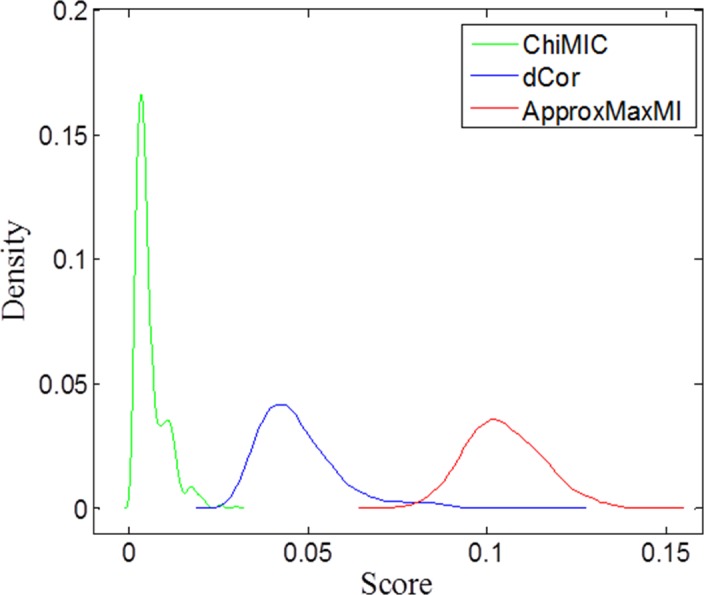
ApproxMaxMI, ChiMIC and dCor estimates were computed for sample size n = 400 over 1000 replicates.
However, the statistical power of dependency measures may depend on different factors, such as pattern types, noise levels and sample sizes. We examine the statistical power of dCor and MIC calculated by ApproxMaxMI and ChiMIC for five different functions with different noise levels. As shown in Fig 8, the statistical powers of MIC calculated by ChiMIC are higher than those of MIC calculated by ApproxMaxMI for all five functional relationships. For linear, parabolic and circular functional relationships, dCor has higher statistical power than those of MIC calculated by ApproxMaxMI and ChiMIC. For sinusoidal function, statistical power of MIC calculated by ApproxMaxMI and ChiMIC are both higher than that of dCor. For checkerboard function, MIC calculated by ApproxMaxMI and ChiMIC outperform dCor at low noise levels, while dCor outperforms at high noise levels.
Fig 8. Statistical power of MIC from ApproxMaxMI, ChiMIC and dCor with different levels of noise, for five kinds of functional relationships.
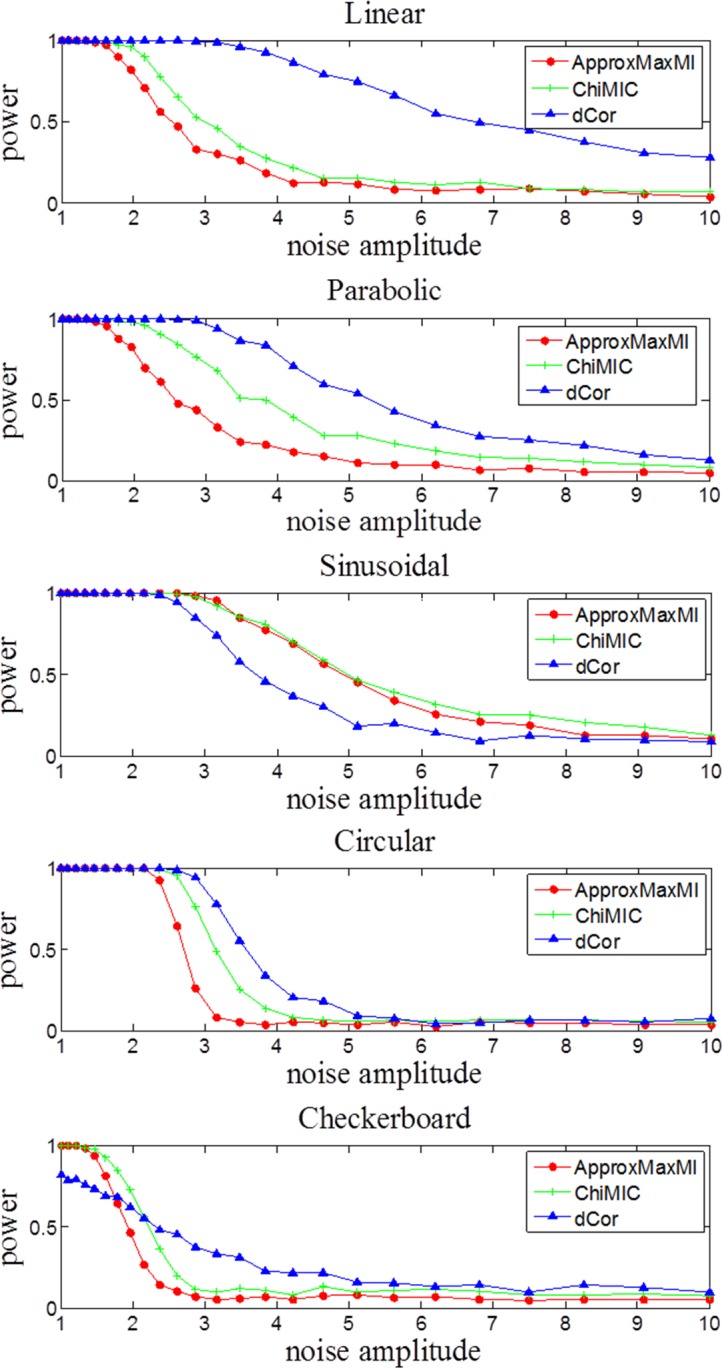
The statistical power was estimated via 500 simulations, with sample size n = 400.
Comparison of computational cost of ApproxMaxMI and ChiMIC
The computational cost of MIC increases as the sample size n increases. With more and more big data available, the computational cost becomes critical for MIC calculating algorithm. We compare the computational time of ChiMIC and ApproxMaxMI using different sizes of independent variable pairs. As shown in Table 1, the run times of ChiMIC algorithm are significantly less than those of ApproxMaxMI algorithm. This is because ChiMIC algorithm uses the chi-square test to terminate grid optimization earlier, while ApproxMaxMI algorithm always tends to search to the maximal grid size B(n). When sample size is 100, ChiMIC algorithm is about 30% faster than ApproxMaxMI algorithm. As samples sizes increase, the advantage of ChiMIC algorithm becomes even more evident. When the sample size is 20000, ChiMIC algorithm runs nearly five times faster than ApproxMaxMI algorithm does. For the parabolic function with noise_LEVEL is 0.4, ChiMIC algorithm also has a faster convergence speed. Thus, ChiMIC algorithm will be a better method for calculating MIC values of big data.
Table 1. Elapsed time for calculating MICs for different sample sizes.
| Number of samples | 100 | 1000 | 2000 | 4000 | 10000 | 20000 | |
|---|---|---|---|---|---|---|---|
| Independent variable pair | ChiMIC (second) | 0.0046±5e-04 | 0.1520±0.03 | 0.537±0.11 | 2.166±0.59 | 12.93±4.1 | 53.55±11 |
| ApproxMaxMI(second) | 0.0061±6e-04 | 0.5229±0.02 | 2.188±0.24 | 8.502±0.12 | 60.02±0.8 | 284.38±11 | |
| Parabolic function (noise_LEVEL = 0.4) | ChiMIC (second) | 0.0021±3e-04 | 0.1325±0.02 | 0.5946±0.12 | 2.754±0.45 | 21.41±3.5 | 99.70±10 |
| ApproxMaxMI(second) | 0.0021±5e-04 | 0.1407±0.03 | 0.7360±0.15 | 3.523±0.54 | 26.65±2.1 | 122.8±12 |
The corresponding time was represented as the average value ± standard deviation over 100 time replicated runs on a Windows 7 32-bit operating system (RAM: 3.00GB, CPU: 2.80 GHz).
Application of MIC values to selecting features for cancer classification
The dependency measures can be used to select features. We compare the MIC values calculated by ApproxMaxMI and ChiMIC in feature selection. We test feature selection on four cancer classification data sets: two microarray datasets (Prostate1 and Prostate2) and two image datasets (WDBC and WPBC). We partition each dataset into a training set and a test set randomly (see details in the Method section). The training set is used for feature selection and classifier construction, and the test set is used for model validation. The retained features and independent test accuracies for the four datasets are shown in Table 2. For the Prostate1 dataset, although the methods based on MIC values from ApproxMaxMI and ChiMIC both select four features, features selected by MIC values from ChiMIC give much higher test accuracy (93.33% vs. 86.67%). For the other three data sets, MIC values from ChiMIC select fewer features than those selected by MIC values from ApproxMaxMI. All classifiers based on features selected by MIC values from ChiMIC obtain higher test accuracy. Especially for the Prostate2 dataset, the test accuracy of classifier based on features selected by MIC values from ChiMIC (80.77) is 11.54% higher than that of classifier based on features selected by MIC values from ApproxMaxMI (69.23%). This result suggests that the features selected by MIC values from ChiMIC are more effective.
Table 2. Retained features and independent test accuracy based on MIC and ChiMIC.
| Datasets | Feature selection method | Selected features | Feature size | Test accuracy (%) |
|---|---|---|---|---|
| Prostate1 | ApproxMaxMI | TRGC2, SERPINF1, NELL2, SPON1 | 4 | 86.67 |
| ChiMIC | TRGC2, HPN, NELL2, LMO3 | 4 | 93.33 | |
| Prostate2 | ApproxMaxMI | SUCO, SMARCD3, XRCC5, PXDC1, CCL2, MAGEA11, MFAP3L, ABCC3, HLA-DPB1 | 9 | 69.23 |
| ChiMIC | SMARCD3, CCND1, ESR1, SSH2, PISD, BRD2, DIS3, RASA3 | 8 | 80.77 | |
| WDBC | ApproxMaxMI | Concave points SE, Worst concave points, Perimeter SE, Mean fractal dimension, Mean perimeter, Mean texture, Worst Radius, Compactness SE, Worst compactness, Radius SE, Mean area | 11 | 97.06 |
| ChiMIC | Concave points SE, Worst concave points, Perimeter SE, Mean fractal dimension, Worst Radius, Worst compactness, Radius SE, Worst fractal dimension | 8 | 97.65 | |
| WPBC | ApproxMaxMI | Mean Radius, Worst compactness, Mean perimeter, Worst concave points, Worst fractal dimension, Symmetry SE, Mean smoothness, Mean compactness, Mean concavity | 9 | 72.88 |
| ChiMIC | Mean Radius, Symmetry SE, Worst concave points, Mean concave points, Worst compactness, Fractal dimension SE | 6 | 76.27 |
Methods
ChiMIC algorithm: determining optimal grid using chi-square test
Same as ApproxMaxMI [9] algorithm, the ChiMIC algorithm partitions a data set of ordered pairs through x-axis and y-axis. Similar to ApproxMaxMI [9] algorithm, the ChiMIC algorithm tries to find optimal partition of x-axis given an equipartition of r bins on y-axis. For example, in Fig 9A, the first optimal endpoint EP1 divides x-axis into two bins. Then, we will use a chi-square test to determine whether the next endpoint is useful. If the p-value of chi-square test is lower than a given threshold, the endpoint is useful and the ChiMIC algorithm continues searching for next optimal endpoint. On the other hand, if the p-value of chi-square test is greater than the given threshold, the endpoint is not useful and the process of partition x-axis is terminated.
Fig 9. Illustration of x-axis partition of ChiMIC.
Colored r×2 contingency tables are used for chi-square test.
The chi-square statistic is defined in Eq (3):
| (3) |
where the mth(m>1) new endpoint EPm divides x-axis into the kth and (k+1)th bin. i (i = 1,2,…,r) denotes the ith bin of y-axis, j(j = k, k+1) denotes the jth bin of x-axis. fij denotes the number of sample points falling into the cell in the ith row and jth column. ni denotes the number of sample points falling in the ith row, Tj denotes the number of sample points falling in the jth column, N denotes the total number of sample points falling in the kth and (k+1)th columns. For example, in Fig 9B, the second optimal endpoint EP2 is selected by dynamic programming. The sample points distributed in the blue area (the x2th column and x3thcolumn in Fig 9B) are used to perform a chi-square test on an r×2 contingency table. If EP2 is useful, then ChiMIC continues searching for the next optimal endpoint. If the next one is EP3, we use the sample points distributed in the green area to perform a chi-square test on an r×2 contingency table (Fig 9C). If p-value is greater than the given threshold, the optimizing process is terminated. For the chi-square test, the minimum expected count in each group is five [28]. The p-value of chi-square test for a 2×2 table with data counts {0, 5; 5, 0} is 0.0114. So we choose 0.01 as the threshold. The Chi-square value needs correction for continuity when r = 2 [29].
Adding noise to functional relationship
The noise to functional relationships in S1 Fig, Fig 2, Fig 3, Fig 4 and Fig 6 are defined as follows:
| (4) |
where f is a functional relationship, and RANGE represents the range of f(X). noise_LEVEL is the relative amplitudes: 0, 0.2, 0.4, 0.6, 0.8, 1.0, 1.2,1.4, 1.6, 1.8, 2.0. RAND(N, 1) is used to generate N random numbers in [0, 1].
The noise functional relationships in Fig 8 are defined in Table 3. Five hundred trial datasets are generated for each of these relationships at each of twenty-five different noise amplitudes (a) distributed logarithmically between 1 and 10. For each dataset, statistics are computed on the “true” data {Xi, Yi}(i = 1,…,400) as well as on “null” data, for which the indices i on the y values are randomly permuted. The power of each statistic is defined as the fraction of true datasets yielding a statistic value greater than 95% of the values yielded by the corresponding null datasets. ξ and η are random numbers drawn from the normal distribution N(0,1). θ is a random number drawn uniformly from the interval [−π, π). (X0,Y0) is a pair of random numbers drawn uniformly from the solid squares of a 4×5 checkerboard, where each square has sides of length 1[26].
Table 3. The X, Y relationships simulated for the power calculations in Fig 8.
| Relationship | X | Y |
|---|---|---|
| Linear | ξ | 2/3X +aη |
| Parabolic | ξ | X2 + aη |
| Sinusoidal | 5/2 θ | 2 cos(X) + aη |
| Circular | 10 cos(θ) + aξ | 10 sin(θ) + aξ |
| Checkerboard | 10 X0 + aξ | 10Y0 + aη |
Real datasets
We use four real datasets to validate the proposed approach. Prostate1 [30] and Prostate2 [31] are gene expression profile datasets. Wisconsin Diagnostic Breast Cancer (WDBC) and Wisconsin Prognostic Breast Cancer (WPBC) [32] are image data of tumor tissues obtained from UCI database, which can be download at http://archive.ics.uci.edu/ml/data. The number of features, positive and negative samples in both training set and test set are listed in Table 4.
Table 4. Datasets: Training set and test set are divided randomly at a ratio of 7:3.
| Dataset | Data type | Feature number | Training set | Test set | ||
|---|---|---|---|---|---|---|
| positive samples | negative samples | positive samples | negative samples | |||
| prostate1 | microarray | 12600 | 35 | 37 | 15 | 15 |
| prostate2 | microarray | 12625 | 35 | 27 | 15 | 11 |
| WDBC | image feature | 32 | 250 | 149 | 107 | 63 |
| WPBC | image feature | 34 | 106 | 33 | 45 | 14 |
Feature selection
For each dataset, first, we calculate MIC values of a vector (X, Y) separately in training set, where X denotes the value of each feature, and Y denotes the phenotype of tumors. Then, we rank all the features in descending order of MIC values. Next, we sequentially introduce the ranked features (only top 200 features for datasets Prostate1 and Prostate2) and remove redundant features using 10-fold cross-validation based on support vector classification (SVC). Finally, we build a SVC prediction model based on retained features using training data and perform independent prediction on test data.
Computational Methods
The ChiMIC (S1 File) and ApproxMaxMI algorithms are both implemented in Matlab. The parameters of ApproxMaxMI are set as a = 0.6, c = 5. dCor and statistical power are computed using Matlab scriptsdownloaded at http://www.sourceforge.net [26]. The SVC is performed using LIBSVM [33] described by Chang et al, and can be downloaded at http://www.csie.ntu.edu.tw/~cjlin/libsvm/index.html.
Supporting Information
(DOCX)
(ZIP)
(DOCX)
(DOCX)
Data Availability
All relevant data are within the paper and its Supporting Information files.
Funding Statement
This work was supported by the Doctoral Foundation of Ministry of Education of China (No. 20124320110002, ZY), http://www.cutech.edu.cn/cn/index.htm; Science and Technology Planning Projects of Changsha, China (No. K1406018-21, ZY), http://www.cssti.cn/html/cskjw/index.html; and National Natural Science Foundation of China (No.31471789, FL), http://www.nsfc.gov.cn/. The funders had no role in study design, data collection and analysis, decision to publish, or preparation of the manuscript.
References
- 1.Hanson B, Sugden A, Alberts B. Making data maximally available. Science. 2011; 331: 649–649. 10.1126/science.1203354 [DOI] [PubMed] [Google Scholar]
- 2.Pearson K. Notes on the history of correlation. Biometrika. 1920; 13: 25–45. [Google Scholar]
- 3.Kendall MG. A new measure of rank correlation. Biometika. 1938; 30: 81–93. [Google Scholar]
- 4.Moon YI, Rajagopalan B, Lall U. Estimation of mutual information using kernel density estimators. Phys Rev E. 1995; 5: 2318–2321. [DOI] [PubMed] [Google Scholar]
- 5.Kraskov A, Stogbauer H, Grassberger P. Estimating mutual information. Phys Rev E. 2004; 69: 066138. [DOI] [PubMed] [Google Scholar]
- 6.Walters-Williams J. Estimation of mutual information: A survey. Lect Notes Comput Sc. 2009; 5589: 389–396. [Google Scholar]
- 7.Szekely GJ, Rizzo M, Bakirov NK. Measuring and testing independence by correlation distance. Ann Stat.2007; 35: 2769–2794. [Google Scholar]
- 8.Delicado P, Smrekar M. Measuring non-linear dependence for two random variables distributed along a curve. Stat Comput. 2009; 19: 255–269. [Google Scholar]
- 9.Reshef DN, Reshef YA, Finucane HK, Grossman SR, McVean G, Turnbaugh PJ, et al. Detecting Novel Associations in Large Data Sets. Science. 2011; 334: 1518–1524. 10.1126/science.1205438 [DOI] [PMC free article] [PubMed] [Google Scholar]
- 10.Zhang Y, Jia S, Huang H, Qiu J, Zhou C. A Novel Algorithm for the Precise Calculation of the Maximal Information Coefficient. Sci Rep-Uk. 2014; 4: 6662. [DOI] [PMC free article] [PubMed] [Google Scholar]
- 11.Speed T. A correlation for the 21st century. Science.2011; 334: 1502–1503. 10.1126/science.1215894 [DOI] [PubMed] [Google Scholar]
- 12.Lin C, Miller T, Dligach D, Plenge RM, Karlson EW, Savova G. Maximal information coefficient for feature selection for clinical document classification. ICML Workshop on Machine Learning for Clinical Data. Edingburgh, UK. 2012.
- 13.Das J, Mohammed J, Yu H. Genome-scale analysis of interaction dynamics reveals organization of biological networks. Bioinformatics. 2012; 28: 1873–1878. 10.1093/bioinformatics/bts283 [DOI] [PMC free article] [PubMed] [Google Scholar]
- 14.Anderson TK, Laegreid WW, Cerutti F, Osorio FA, Nelson EA, Christopher-Hennings J, et al. Ranking viruses: measures of positional importance within networks define core viruses for rational polyvalent vaccine development. Bioinformatics. 2012; 28: 1624–1632. 10.1093/bioinformatics/bts181 [DOI] [PubMed] [Google Scholar]
- 15.Song L, Langfelder P, Horvath S. Comparison of co-expression measures: mutual information, correlation, and model based indices. BMC bioinformatics. 2012; 13: 328 10.1186/1471-2105-13-328 [DOI] [PMC free article] [PubMed] [Google Scholar]
- 16.Riccadonna S, Jurman G, Visintainer R, Filosi M, Furlanello C. DTW-MIC coexpression networks from time-course data. arXiv preprint arXiv: 1210.3149, 2012. [DOI] [PMC free article] [PubMed]
- 17.Moonesinghe R, Fleming E, Truman BI, Dean HD. Linear and non-linear associations of gonorrhea diagnosis rates with social determinants of health. Inter J Env Res Pub Heal. 2012; 9: 3149–3165. [DOI] [PMC free article] [PubMed] [Google Scholar]
- 18.Lee SC, Pang NN, Tzeng WJ. Resolution dependence of the maximal information coefficient for noiseless relationship. Stat Comput. 2014; 24: 845–852. [Google Scholar]
- 19.de Souza RS, Maio U, Biffi V, Ciardi B. Robust PCA and MIC statistics of baryons in early minihaloes. Mon Not R Astron Soc. 2014; 440: 240–248. [Google Scholar]
- 20.Zhang Z, Sun S, Yi M, Wu X, Ding Y. MIC as an Appropriate Method to Construct the Brain Functional Network. Biomed Res Int. 2015; 2015: 825136 10.1155/2015/825136 [DOI] [PMC free article] [PubMed] [Google Scholar]
- 21.Tang D, Wang M, Zheng W, Wang H. RapidMic: Rapid Computation of the Maximal Information Coefficient. Evol Bioinformatics Online. 2014; 10: 11. [DOI] [PMC free article] [PubMed] [Google Scholar]
- 22.Wang S, Zhao Y. Analyzing Large Biological Datasets with an Improved Algorithm for MIC. arXiv preprint arXiv:1403.3495. 2014.
- 23.Albanese D, Filosi M, Visintainer R, Riccadonna S, Jurman G, Furlanello C. minerva and minepy: a C engine for the MINE suite and its R, Python and MATLAB wrappers. Bioinformatics. 2013; 29: 407–408. 10.1093/bioinformatics/bts707 [DOI] [PubMed] [Google Scholar]
- 24.Reshef DN, Reshef YA, Finucane HK, Grossman SR, McVean G, Turnbaugh PJ, et al. Supporting Online Material for Detecting Novel Associations in Large Data Sets. Science. 2011; 334: 1518–1524. 10.1126/science.1205438 [DOI] [PMC free article] [PubMed] [Google Scholar]
- 25.Gorfine M, Heller R, Heller Y. Comment on “Detecting Novel Associations in Large Data Sets”[EB/OL]. 2014. Available: http://www.math.tau.ac.il/~ruheller/Papers/science6.pdf.
- 26.Kinney JB, Atwal GS. Equitability, mutual information, and the maximal information coefficient. Proc. Natl Acad. Sci. USA. 2014; 111: 3354–3359. 10.1073/pnas.1309933111 [DOI] [PMC free article] [PubMed] [Google Scholar]
- 27.Simon N, Tibshirani R. Comment on ‘Detecting novel associations in large data sets’ by Reshef et al, Science Dec 16, 2011. arXiv preprint arXiv:1401, 7645. 2014. Available: http://statweb.stanford.edu/~tibs/reshef/comment.pdf.
- 28.Cochran WG. Sampling Techniques. 2st ed. New York: John Wiley & Sons; 1963. [Google Scholar]
- 29.Yates F. Contingency tables involving small numbers and the χ2 test. J Roy Stat Soc. 1934; Suppl.1: 217–235. [Google Scholar]
- 30.Singh D, Febbo PG, Ross K, Jackson DG, Manola J, Ladd C, et al. Gene expression correlates of clinical prostate cancer behavior. Cancer Cell. 2002; 2: 203–209. [DOI] [PubMed] [Google Scholar]
- 31.Stuart RO, Wachsman W, Berry CC, Wang-Rodriguez J, Wasserman L, Klacansky I, et al. Stuart In silico dissection of cell-type-associated patterns of gene expression in prostate cancer. Proc. Natl Acad Sci USA. 2004; 101: 615–620. [DOI] [PMC free article] [PubMed] [Google Scholar]
- 32.Blake CL, Merz CJ. UCI repository of machine learning databases. Available: http://www.ics.uci.edu/~mlearn/mlrepository.html. University of California, Irvine, Dept. of Information and Computer Sciences, 1998.
- 33.Chang CC, Lin CJ . LIBSVM: a library for support vector machines. Acm T Intel Syst Tec. 2011; 2: 27. [Google Scholar]
Associated Data
This section collects any data citations, data availability statements, or supplementary materials included in this article.
Supplementary Materials
(DOCX)
(ZIP)
(DOCX)
(DOCX)
Data Availability Statement
All relevant data are within the paper and its Supporting Information files.



